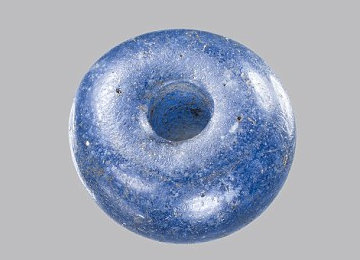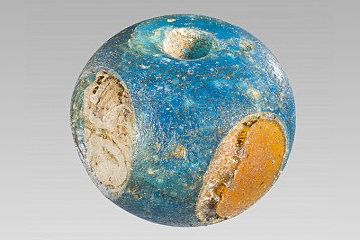International Beads
Glass-making is a skilled and intricate process. You have to have clean quartz sand to begin with, but there is more to it than simply heating the sand hot enough to melt it. The sand has to be mixed with soda (sodium carbonate), which early glass-makers obtained by burning plants such as kelp (in Britain) and other types of vegetation, and lime, which can be obtained from limestone or from the shells of sea creatures.
Around 1400 BC a glass-maker in Mesopotamia set fire to a pile of reeds plucked from the banks of the Tigris River and allowed them to burn down to ash. It is highly likely that he also crushed and baked the shells of snails and shellfish, because there is no stone in Mesopotamia - unless, of course, he had access to limestone transported all the way from the mountains of Elam to the east or the hill country of Assyria to the north. Sand, of course, was not a problem; he was living on the edge of one of the largest sandy deserts in the world, the wastes that separate Mesopotamia from Palestine and continue south into Arabia.
With his ingredients assembled, our hero cut down another couple of palm trees and used their timber to fuel his furnace. He placed the sand, soda ash and lime in a pottery crucible and started to pump his bellows to get the fire hot enough to melt the sand. At the last minute, however, he sent a boy across to the nearby coppersmigh and begged a handful of copper slag, which he added to the mix. He knew what it did, but he didn't know that the copper waste was rich in an element that didn't even have a name back then - cobalt.
Exactly what he did when the glass was finally molten we do not know; he might have poured it into a mold and then, when the resulting block of glass was cold, chiselled it into shape. A more economical method would have been to either pour the glass into tiny molds or to use a tool for pulling out little blobs of glass. Whatever the technique, the end result was the same - hundreds, or possibly thousands, of little shiny glass beads, each one a deep blue in colour.
Once the beads were ready the glass-maker gathered them up and put them in a bag or basket, then carried them down the street to a merchant who, he knew, had a buyer for his beads. The two haggled over the price but eventually a satisfactory deal was arranged and the glass-maker went back to start hunding for more reeds and snails so that he could produce his next batch of glass.
The merchant, on the other hand, loaded the bag of beads - plus various other objects he had acquired - onto a donkey and set off for the nearest big city. It might have been Nippur, where he sold his merchandise to another, larger merchant; it might have been south to Ur, where the merchandise was put on board a boat that would sail down the Persian Gulf, around the southern end of Arabia and up the Red Sea; it might even have been north to somewhere like Babylon where the beads would have been put on board a camel or donkey caravan and shipped out around the Fertile Crescent and then down the well-worn trade routes along the coast or through the Judean hills and across the Sinai Desert.
The ultimate destination was Egypt, a country which was in the market for luxury goods from every part of the world and had the gold to pay for them, for in Egypt gold was as common as dust - or at least, that is what people in less favoured countries believed. Sooner or later the bag of beads ended up in a shop in Memphis where an Egyptian merchant put them on display and sat back to wait for buyers.
The first customer was a fair-haired man who spoke excrable Egyptian with an awful accent. He wanted the beads but his problem was how to buy them? His first offer was a slave girl with long, curly, blonde hair, but the Egyptian merchant shook his head. He wasn't a slave dealer - slaves were too chancy: they might get sick and die, they might run away, and while you waited for a buyer they had to be fed and clothed.
The man's next offer was more interesting; a handful of yellow beads, one of which had an insect embedded in it. The Egyptian was interested, but he wasn't sure whether he would find a buyer for these unusual yellow stones, so he only offered a couple of blue glass beads in exchange for the handful of amber. Eventually, however, they settled on an exchange that pleased them both, and the stranger went on his way. Probably he was eager to leave the dry heat of Egypt, for his home lay far to the north, not only on the other side of the Middle Sea, but many weeks travel through endless forests to another sea where he lived on a large, flat island where the snow lay deep in winter.

| |
| A bead of Egyptian glass found in a burial at Ĝlby, in Denmark |
Once he arrived at his little village he put the beads on display, where they caught the eye of one of the wealthiest women in the area. She liked the beads and duly bought one - all she could afford - but it may have been her last purchase, for she was already old. She died and the whole settlement turned out to see her buried in a coffin carved from an oak log. Her body was adorned with her most precious possessions: a skirt of bronze tubes that tinkled as she walked, a heavy bronze disk that held her girdle in place, a bracelet of amber beads, and that beautiful blue bead that, as far as she was concerned, came from Egypt.
Meanwhile back in Memphis our merchant received a visit from a man who was looking for raw materials. He wasn't unduly bothered about the fact that this glass was in the form of beads; he wanted to grind it down to use as filling in the intricate death mask he had been commissioned to make. There was no hurry, for the pharaoh for whom the death mask was intended was still a relatively young boy and everyone expected him to live for many years. They hoped that he would bring stability and prosperity to Egypt after the tumultuous disturbances of his father, who had been obsessed with some new god.

| |
| This bead was found in a workshop at Tel el-Amarna. |
Three thousand four hundred years go by and a man called Howard Carter peers through a hole in the door of that pharaoh's tomb and gasps to his impatient sponsor, "I can see wonderful things". However it wasn't until he had cleared the outer tomb and dismantled the gold-plated wooden shrines that filled the burial chamber, that Howard Carter was able to open the sarcohagus and gaze in wonder on the amazing death mask of Tutankhamun, with its inlay of semi-precious blue paste.
He probably wasn't even aware that fifty years previously a Danish archaeologist called Sophus Muller, digging in the little village of Ĝlby, some twenty-five miles south of Copenhagen, had uncovered the burial of a rich woman who lay in an oaken coffin. She had no gold, only a few bronze objects, a handful of amber beads and one striking blue bead - and it is that bead which is giving us valuable insights into the network of trade routes that spanned the ancient world.
Jeanette Varberg from the Moesgaard Museum and Flemming Kaul from the Danish National Museum and the French Institute for the Research of Ancient Materials in Orleans cooperated to analyse the blue bead. Using plasma-spectrometry that enables the chemical composition of the glass to be analysed non-destructively, the experts were able to show that the glass was identical to glass found at Amarna and other cobalt glass from Nippur in Mesopotamia.
Somewhat to their surprise, the archaeologists found that glass beads have been found in association with amber at sites in Turkey, Greece, Italy, Germany and Egypt. Naturally the archaeologists would hang their heads in shame if they did not bring "cultic" connections into the picture and they now speculate that these beads are "proof" of a link between the Egyptian sun cult - do they mean Akhenaton's worship of the Aten? - and a putative Nordic sun cult. Occam's Razor would seem to me to indicate that the fact that yellow and blue make a pleasing contrast that would attract someone with an eye for bright colours is a more likely explanation.
blonde hair One of the tombs excavated by Sir Flinders Petrie at Kahun contained the mummified remains of a woman with long, curly, blonde hair. So far as I know, no modern investigation of this woman has been done, which is a pity, because genetic analysis could identify her race and other forms of investigation might even be able to pin down the place she came from. However I think it is safe to say that she must have come from northern Europe. Return
© Kendall K. Down 2015





